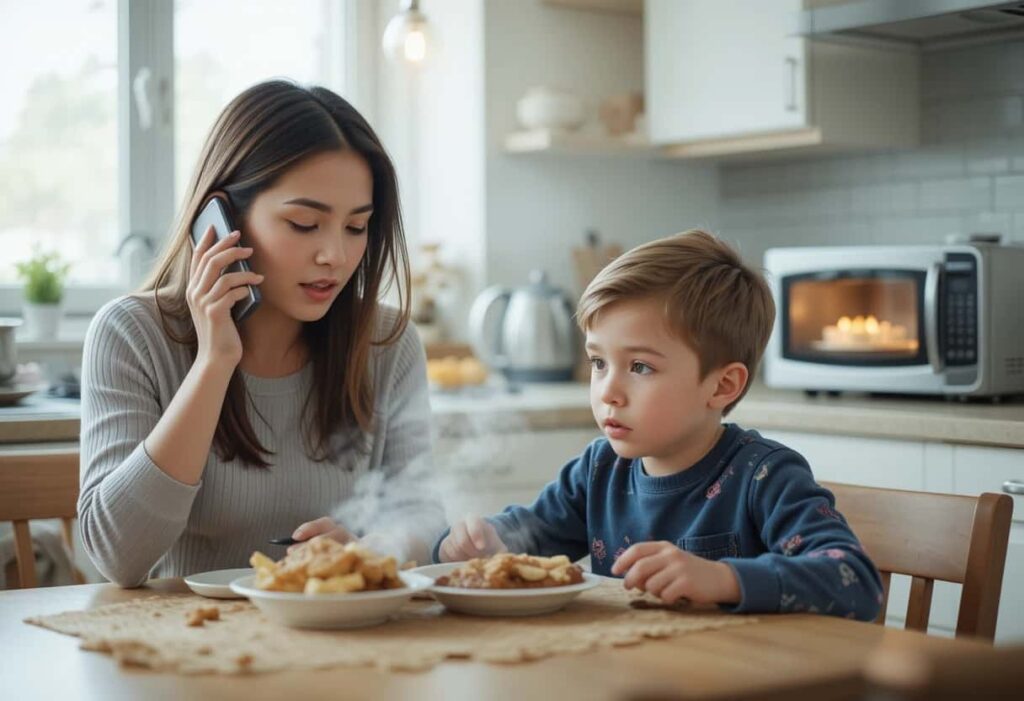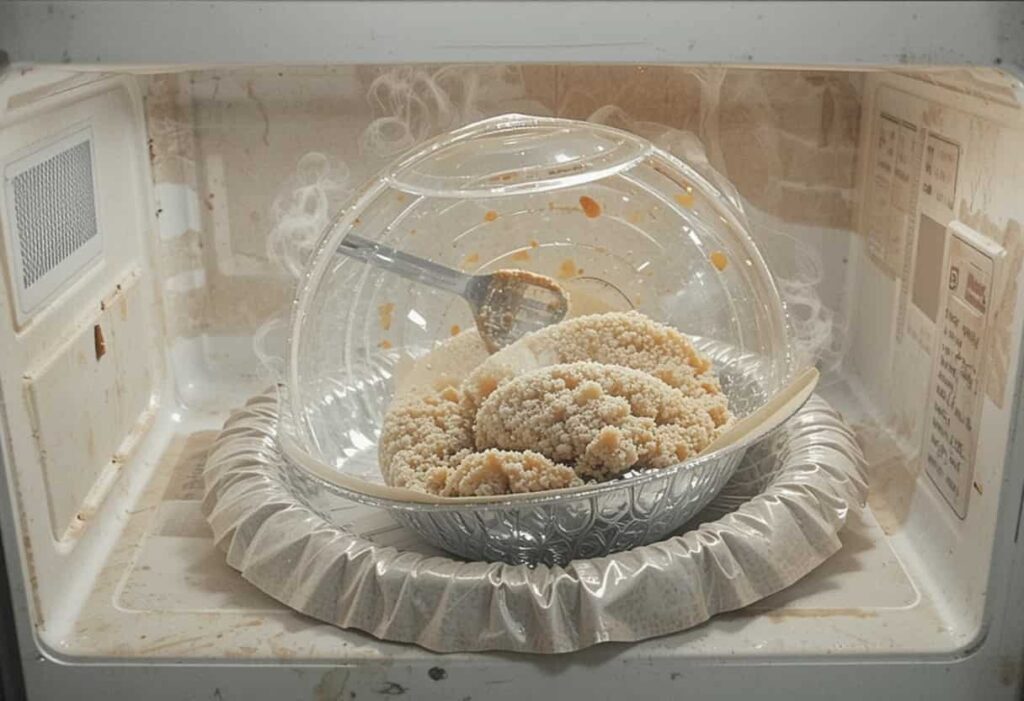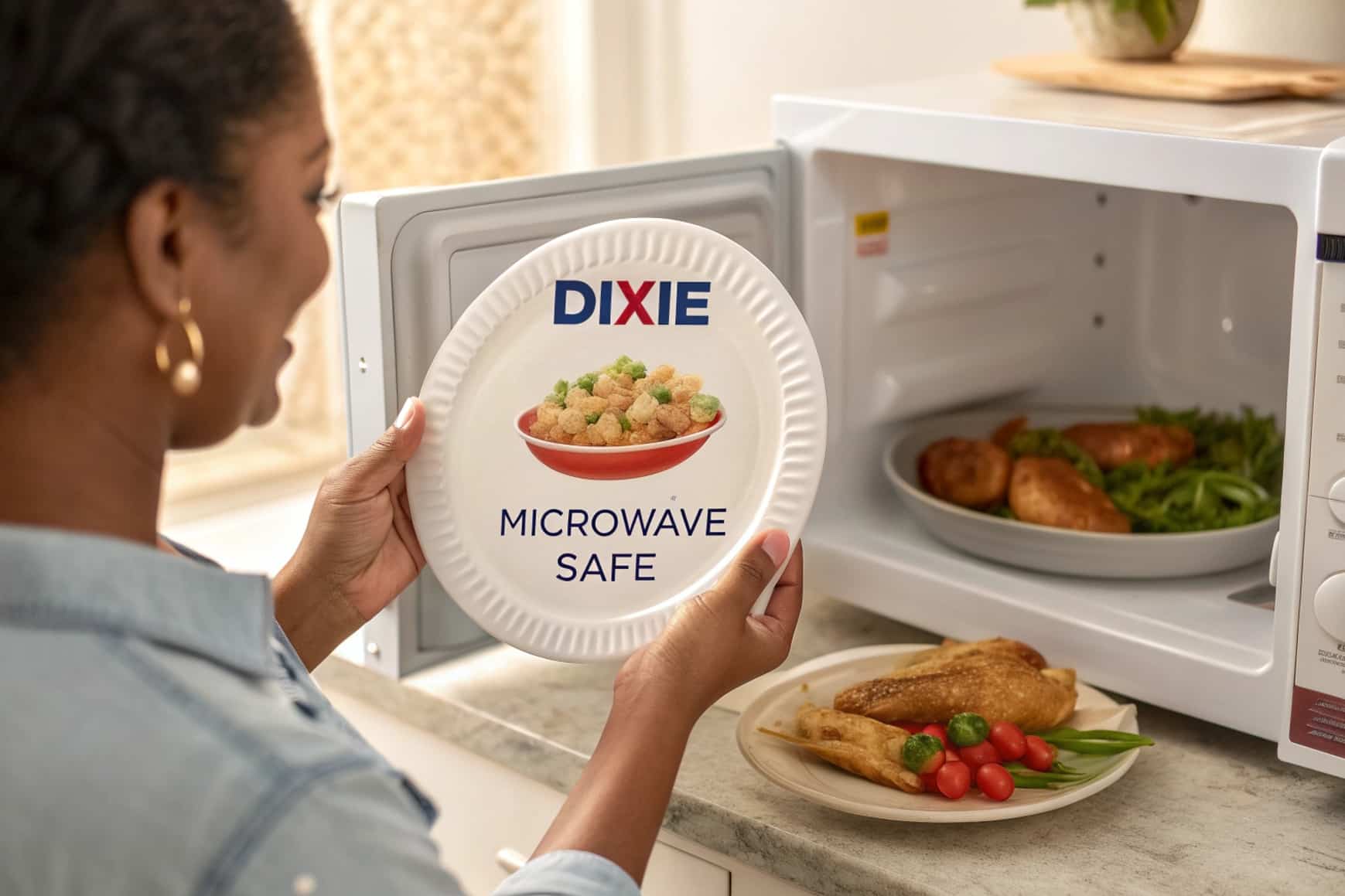Microwaving food is a quick and convenient way to reheat meals, but not all containers are safe for microwave use. One common question many people have is: Are Dixie paper plates microwave safe? The answer isn’t as straightforward as a simple yes or no—it depends on factors like plate composition, food type, and microwave settings.
In this comprehensive guide, we’ll explore everything you need to know about microwaving Dixie paper plates safely. We’ll cover manufacturer guidelines, expert recommendations, potential risks, and best practices to ensure your meals are reheated without any hazards.
My Personal Story – Why I Wanted to Know This!
I’m a mother of two and also work from home. That means I’m always juggling a hundred things at once. One afternoon, I had to warm up some leftover spaghetti for my son. Without thinking much, I placed the food onto a Dixie paper plate and put it in the microwave. About a minute later, I noticed some steam rising and a strange smell in the kitchen.

It wasn’t a burning smell, but something unusual that made me pause. That moment made me wonder if using that paper plate in the microwave was truly safe.Later that evening, I began reading product labels and searching online for clear information. What I discovered was surprising and made me more cautious about what I put into the microwave. If anyone else is having the same concern, the information below will help provide clarity
What Are Dixie Paper Plates Made Of?
Before we answer whether they’re microwave-safe, let’s understand what Dixie paper plates are made of.Dixie paper plates are made using paper from responsibly sourced wood fiber, and they are coated with a light layer that makes them more durable.
This coating helps prevent oil and moisture from soaking through. That’s why they don’t become soggy easily—even when you put hot or greasy food on them.But here’s the catch: some people assume that all coated paper plates are unsafe for the microwave. That’s not always true, especially in the case of Dixie.
What Does the Manufacturer Say?
According to Dixie’s official website and packaging, their paper plates are safe to use in the microwave for reheating food. However, they also provide some warnings:
- Only use the plate for reheating (not for cooking raw food).
- Heating time should be short.
- Microwaves vary in power, so always watch the plate while heating.
- Avoid reheating food that’s too greasy or oily.
So the answer is yes — Dixie paper plates are microwave safe, but they must be used with care.
Are Dixie Paper Plates Microwave Safe?
Dixie paper plates are generally safe for microwave use when following proper guidelines. Most plain, uncoated Dixie plates can be used for short reheating periods (30-60 seconds), especially when labeled as microwave-safe. However, plates with plastic coatings, printed designs, or wax finishes should be avoided as they may melt or transfer chemicals when heated.
For optimal safety, use only for reheating (not cooking), avoid greasy foods that can weaken the plate, and check for any warping or damage after microwaving. When uncertain, transfer food to ceramic or glass containers instead.
What Does the USDA Say About Microwaving Paper Plates?
- USDA Guidelines: The USDA says plain white paper plates, paper towels, and napkins are microwave-safe as long as they do not contain plastic, foil, or metallic ink, which can cause fire or release harmful chemicals.
- Dixie Plate Design: Dixie paper plates are usually white and free from heavy designs or metallic ink, making them safer compared to many cheap or decorative plates found in stores.
- Avoid Coated Plates: Plates with plastic coatings or shiny finishes should be avoided in the microwave because they can melt, spark, or leach chemicals into your food.
- Dixie’s Microwave Advice: Dixie confirms their plates can be used for reheating food in the microwave, but they advise users to follow safety steps like watching the heating time and microwave settings.
- Safety Tip: To stay safe, always choose plain, uncoated, microwave-safe paper plates and avoid using them for too long or at high temperatures.
My Personal Experience with Dixie Paper Plates in the Microwave:
Since my spaghetti incident, I’ve become more cautious about using Dixie paper plates in the microwave. I’ve found that reheating rice, pasta, and vegetables for 1-2 minutes works perfectly with no signs of burning or warping. Sandwiches and kids’ meals like chicken nuggets warm up well in less than 1.5 minutes.
However, I avoid greasy foods like fried chicken because the excess oil makes the plate soggy and can cause warping. I also avoid microwaving for more than 2-3 minutes at a time and stacking plates, as they can lose their shape. Overall, short bursts of heat work best for keeping the plate intact. Always check the plate’s condition before reheating for extended periods. These small adjustments have made microwaving with Dixie plates much safer.
Potential Risks of Microwaving Dixie Paper Plates:
While generally safe, improper use can lead to:
Fire Hazard Potential:
When microwaving Dixie plates, excessive heat exposure can create dangerous situations. Overheating dry items like toast or crackers may lead to scorching, while prolonged microwaving could potentially cause combustion. Always monitor cooking times carefully and never leave microwaving plates unattended.
Chemical Contamination Concerns:
The decorative elements on some plates pose hidden risks. Printed designs often contain inks that may leach into food when heated, and plastic coatings can degrade under high temperatures. For safest use, stick to plain, uncoated white plates whenever possible.
Structural Stability Issues:
Paper plates struggle with certain food types. Oily foods gradually break down the plate’s structure, while liquid-heavy meals can cause sudden failures. Watch for warping or softening during use, as these warn of impending structural collapse that could spill hot contents.
Safety Recommendations:
To minimize risks:
- Verify microwave-safe labeling
- Use only for brief reheating
- Avoid high-fat or watery foods
- Inspect plates after each use
- Consider alternatives for extended cooking
By understanding these risks and following precautions, you can safely utilize Dixie plates for convenient microwave use while avoiding potential hazards.
Common Mistakes People Make with Microwave and Paper Plates:
Sometimes, it’s not about the plate, but how we use it. Here are some mistakes I’ve seen (and made myself!):
Using Foil with Paper Plates:
Never use foil on a paper plate when microwaving. Foil in the microwave can cause sparks and fires due to its metal properties, and it can also damage the microwave. The combination of metal and microwave radiation can create dangerous situations. Always use microwave-safe containers made of glass, ceramic, or plastic for safety.
Microwaving Too Long Without Checking:
Leaving a paper plate in the microwave for too long without checking it can lead to the plate becoming weak, soggy, or even burning. Paper plates aren’t designed to handle extended heat exposure. It’s essential to monitor your food regularly, especially when reheating, to avoid mishaps or overheating the plate, which may cause it to lose its strength.
Heating Frozen Greasy Foods:
Microwaving frozen greasy foods directly on a paper plate is not recommended. The excess oil from fried foods like chicken or pizza can seep into the paper, weakening it and making it soggy. This can cause the plate to break apart or even catch fire in extreme cases. Use microwave-safe glass or ceramic containers for these foods instead.

Ignoring Warning Signs:
If you notice any signs of steam, plate discoloration, or unusual smells coming from the paper plate, immediately stop the microwave. These signs indicate the plate is under too much heat, which can cause it to lose its integrity or become unsafe. Discoloration or strange odors often signal that the plate is beginning to break down, posing potential hazards.
Overloading the Microwave:
When you overload the microwave with too much food on a paper plate, the heat may not distribute evenly, causing uneven cooking or reheating. This can lead to spills, messes, or even overheating the plate. It’s better to heat smaller portions at a time, ensuring your food heats thoroughly and the plate stays intact.
What If I Need a More Durable Option?
For foods that are very oily, wet, or that need longer heating times, I’ve started using microwave-safe glass bowls or ceramic plates. Then I transfer the food to a Dixie plate when it’s ready to eat. This helps prevent the plate from becoming soggy or weak during the reheating process.
Additionally, glass and ceramic are more durable and provide better heat resistance, making them a safer option for longer heating. Sometimes, convenience isn’t worth the risk — but Dixie does a great job for short reheating sessions. Using a more durable option ensures both safety and better food quality.
Best Practices for Microwaving Dixie Paper Plates:
Use Short Heating Intervals:
When microwaving with Dixie plates, always use 30-second bursts and check the plate’s condition between intervals. This prevents overheating that could lead to warping, scorching, or even combustion. Short cycles allow you to monitor food temperature and plate integrity, ensuring safe results. This method is especially crucial for foods that heat unevenly. After each interval, inspect for any structural changes before continuing.
Avoid High-Fat or Liquid-Heavy Foods:
Greasy foods like pizza or saucy meals accelerate plate breakdown. The oils penetrate paper fibers while steam weakens the structure, increasing spill risks. Moisture causes plates to become soggy and unstable. For such foods, transfer to microwave-safe ceramic or glass containers instead. This prevents messy accidents and maintains food quality.
Never Use for Cooking, Only Reheating:
Dixie plates aren’t designed for cooking – only brief reheating. Cooking involves prolonged heat exposure that can melt coatings or ignite the plate. Limit use to warming pre-cooked foods for 1-2 minutes maximum. For actual cooking, always use proper cookware rated for microwave use. This distinction prevents safety hazards.
Opt for Microwave-Safe Alternatives When Unsure:
If any doubt exists about a plate’s safety, immediately switch to glass or ceramic alternatives. These materials withstand higher temperatures without risks of leaching or structural failure. Keep dedicated microwave containers handy for questionable situations. When in doubt, it’s always better to err on the side of caution.
Additional Safety Tip:
Always verify the microwave-safe label before use. Unmarked plates should be presumed unsafe. Following these guidelines ensures you benefit from Dixie’s convenience without compromising safety. Proper usage prevents accidents while maintaining food quality and plate performance. Remember that microwave wattages vary, so adjust times accordingly.
Tips for Microwaving Dixie Paper Plates Safely:
Based on my experience (and advice from experts), here are some safety tips you should always follow:
- Check the Label: Always look for the “Microwave Safe” label on Dixie paper plates. This ensures that the plate has been tested and approved for microwave use. If the label is missing, avoid using the plate in the microwave, as it might not withstand the heat, causing damage or even releasing harmful chemicals.
- Only Reheat, Don’t Cook: Dixie paper plates are designed for reheating, not for cooking food from raw. They’re typically not durable enough to handle the high temperatures required for cooking. Using them for reheating will ensure the plate maintains its structure, while cooking may cause it to warp, catch fire, or disintegrate.
- Use Short Time Intervals: It’s always best to microwave in short bursts—about 30 seconds to start. If the food needs more time, increase it in 15-30 second intervals. This helps avoid overheating the plate, which can cause it to soften or lose its shape, reducing the chance of spills or accidents.
- Avoid Oily or Wet Foods: Paper plates absorb moisture, and excess oil or water can cause the plate to weaken and become soggy. Foods like fried chicken, burgers, or soups can leak oil or water, leading to potential messes. For such foods, consider using microwave-safe glass or ceramic dishes that can better withstand moisture and grease.
- Don’t Use Damaged Plates: If the Dixie paper plate is damaged, whether it has a tear, crease, or is warped, it should not be used. Damaged plates are more likely to break down under heat, causing leaks or even catching fire in the microwave. Always inspect the plate before use to ensure it’s intact and safe.
FAQS:
1. Are Dixie paper plates safe for reheating leftovers?
Yes, Dixie paper plates are safe for reheating leftovers in the microwave, as long as they’re used correctly. Avoid greasy foods or extended microwaving times, as they can weaken the plate. Always check for a “microwave-safe” label to ensure safety.
2. Can I microwave a Dixie paper plate with food that has a lot of sauce or oil?
It’s best to avoid microwaving foods with excessive oil or sauce directly on Dixie paper plates. The grease can cause the plate to weaken and become soggy. Instead, use a more durable container, like a glass or ceramic bowl, for these types of foods.
3. What should I do if my Dixie paper plate starts to smell or discolor in the microwave?
If your Dixie paper plate starts to smell or discolor, it’s a sign that the plate is absorbing too much heat. Immediately stop microwaving and remove the plate. Discoloration or unusual smells indicate that the plate is breaking down, and continuing to heat it could be unsafe.
4. Can I use a Dixie paper plate for reheating frozen food in the microwave?
While you can use Dixie paper plates for reheating many types of food, it’s not ideal for frozen foods. Frozen meals, especially those that are greasy or watery, may cause the plate to become soggy or damaged. It’s safer to use a microwave-safe container, such as glass, for frozen foods.
5. How can I avoid accidents when using Dixie paper plates in the microwave?
To prevent accidents, always check that the plate is labeled “microwave-safe,” avoid using overly greasy foods, and don’t microwave for extended periods. Use short intervals and check the food frequently to avoid overheating or damaging the plate. Also, never stack multiple plates together, as it can cause uneven heating.
Conclusion:
In conclusion, Dixie paper plates can be safely used in the microwave for reheating food, provided they are used with caution. It’s important to follow the manufacturer’s guidelines, such as avoiding oily or saucy foods, using short heating intervals, and ensuring the plate is labeled “microwave-safe.” While they are a convenient option for quick reheating, it’s essential to check the plate’s condition during use to prevent damage or potential hazards.
For longer cooking times or greasier foods, consider using more durable materials like glass or ceramic containers. Always inspect the plate for any signs of wear before use, as damaged plates are more likely to fail under heat. By following these precautions, you can safely enjoy reheating your meals with Dixie plates.
Related post:
- Are Ball Mason Jars Microwave Safe – Avoid These Common Mistakes!
- Apples Baked In Microwave – A Cozy, Guilt-Free Dessert In Just Minutes!
- Above Range Microwave Stainless Steel – A Practical Kitchen Upgrade!
